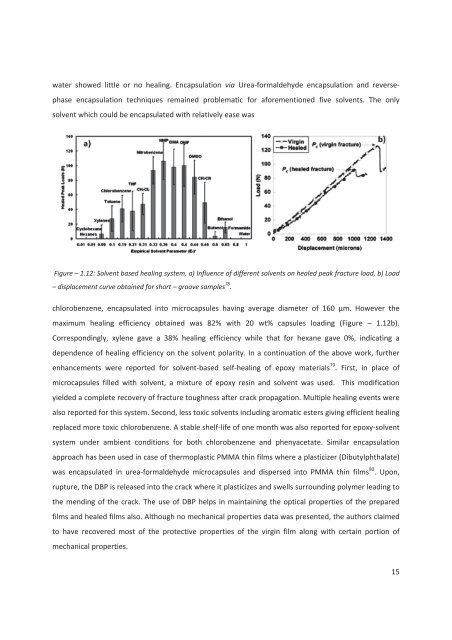4(%3)3 - Ecole nationale supérieure de chimie de Montpellier
4(%3)3 - Ecole nationale supérieure de chimie de Montpellier
4(%3)3 - Ecole nationale supérieure de chimie de Montpellier
Create successful ePaper yourself
Turn your PDF publications into a flip-book with our unique Google optimized e-Paper software.
water showed little or no healing. Encapsulation via Urea-formal<strong>de</strong>hy<strong>de</strong> encapsulation and reversephaseencapsulation techniques remained problematic for aforementioned five solvents. The onlysolvent which could be encapsulated with relatively ease wasFigure – 1.12: Solvent based healing system, a) Influence of different solvents on healed peak fracture load, b) Load– displacement curve obtained for short – groove samples 78 .chlorobenzene, encapsulated into microcapsules having average diameter of 160 µm. However themaximum healing efficiency obtained was 82% with 20 wt% capsules loading (Figure – 1.12b).Correspondingly, xylene gave a 38% healing efficiency while that for hexane gave 0%, indicating a<strong>de</strong>pen<strong>de</strong>nce of healing efficiency on the solvent polarity. In a continuation of the above work, furtherenhancements were reported for solvent-based self-healing of epoxy materials 79 . First, in place ofmicrocapsules filled with solvent, a mixture of epoxy resin and solvent was used. This modificationyiel<strong>de</strong>d a complete recovery of fracture toughness after crack propagation. Multiple healing events werealso reported for this system. Second, less toxic solvents including aromatic esters giving efficient healingreplaced more toxic chlorobenzene. A stable shelf-life of one month was also reported for epoxy-solventsystem un<strong>de</strong>r ambient conditions for both chlorobenzene and phenyacetate. Similar encapsulationapproach has been used in case of thermoplastic PMMA thin films where a plasticizer (Dibutylphthalate)was encapsulated in urea-formal<strong>de</strong>hy<strong>de</strong> microcapsules and dispersed into PMMA thin films 80 . Upon,rupture, the DBP is released into the crack where it plasticizes and swells surrounding polymer leading tothe mending of the crack. The use of DBP helps in maintaining the optical properties of the preparedfilms and healed films also. Although no mechanical properties data was presented, the authors claimedto have recovered most of the protective properties of the virgin film along with certain portion ofmechanical properties.15











